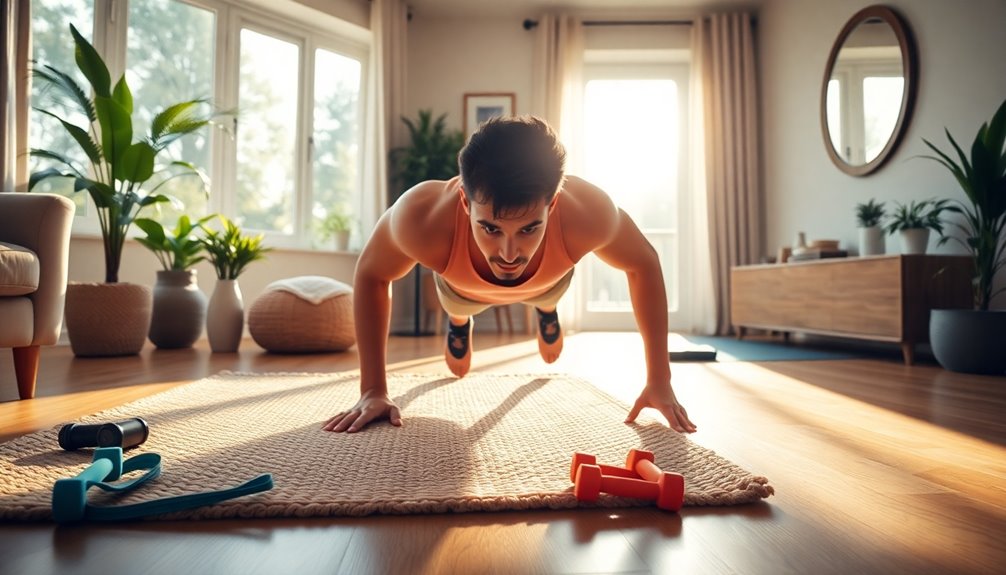You can easily get fit at home with these 10 bodyweight exercises! Start with push-ups to strengthen your chest and triceps. Move on to squats and lunges for lower body power. Planks build core strength, while burpees add a cardio kick. Don't forget tricep dips for those upper arms! Glute bridges target your glutes and lower back, and high knees boost your heart rate. Bicycle crunches sculpt your abs, and mountain climbers engage your core effectively. These exercises offer a full-body workout, making fitness accessible for all levels. Stick around, and you'll discover even more ways to enhance your home routine!
Key Takeaways
- Push-Ups effectively strengthen multiple upper body muscles and can be modified for different fitness levels with variations like knee push-ups.
- Squats target the lower body, improving strength in thighs, glutes, and calves while allowing for variations like sumo and jump squats.
- Planks build core strength and stability, with options like side planks for added challenge and engagement of multiple muscle groups.
- Burpees combine strength and cardio, making them a time-efficient full-body exercise suitable for various fitness levels and goals.
- Incorporate lunges to enhance balance and coordination, with variations such as static and walking lunges to keep workouts engaging.
Push-Ups
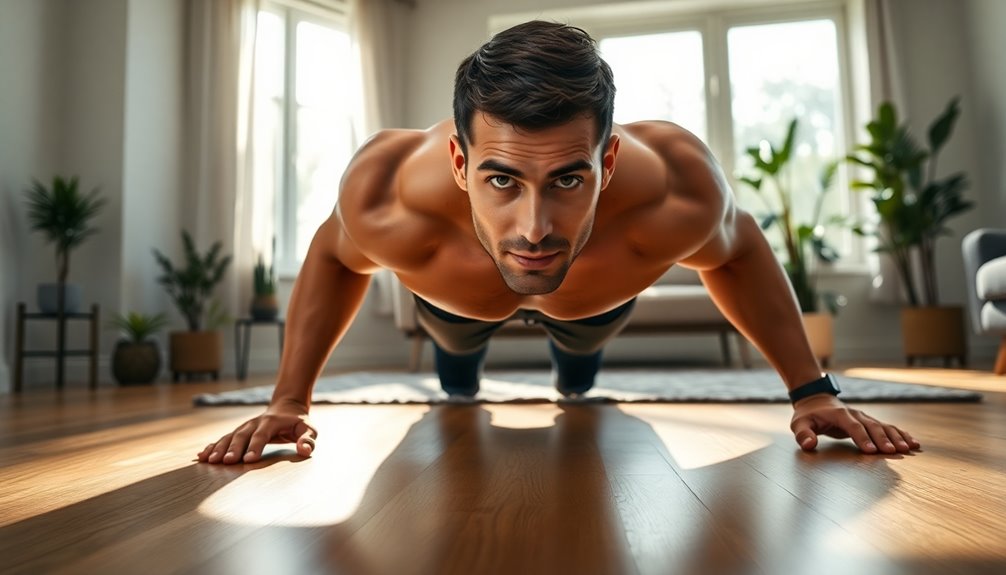
Push-ups are one of the most effective bodyweight exercises you can do at home, targeting multiple muscle groups with each rep. When you're pushing up from the ground, you engage your chest, shoulders, triceps, and even your core. To maximize the benefits, you need to focus on proper form. Keep your body in a straight line from head to heels, and don't let your hips sag or your back arch. This alignment is essential for avoiding injury and ensuring that you're working the right muscles.
If you're new to push-ups or find them challenging, don't worry! There are plenty of variations and modifications to suit your fitness level. You can start with knee push-ups, where you keep your knees on the ground for support. As you gain strength, you can move on to incline push-ups by placing your hands on a sturdy surface, like a bench or a wall. These adjustments not only make push-ups more accessible but also help you build confidence in your abilities.
As you progress, try incorporating different styles of push-ups, such as wide-grip, diamond, or even explosive push-ups. Each variation offers unique challenges and targets different muscle groups, keeping your workouts fresh and engaging. Additionally, incorporating glute-specific movements can enhance your overall strength and improve your push-up performance, as glute strength impacts lifting capacity. Remember, every small step you take contributes to your overall strength and fitness journey. So, embrace the process, and you'll soon find push-ups becoming a staple in your home workout routine!
Squats
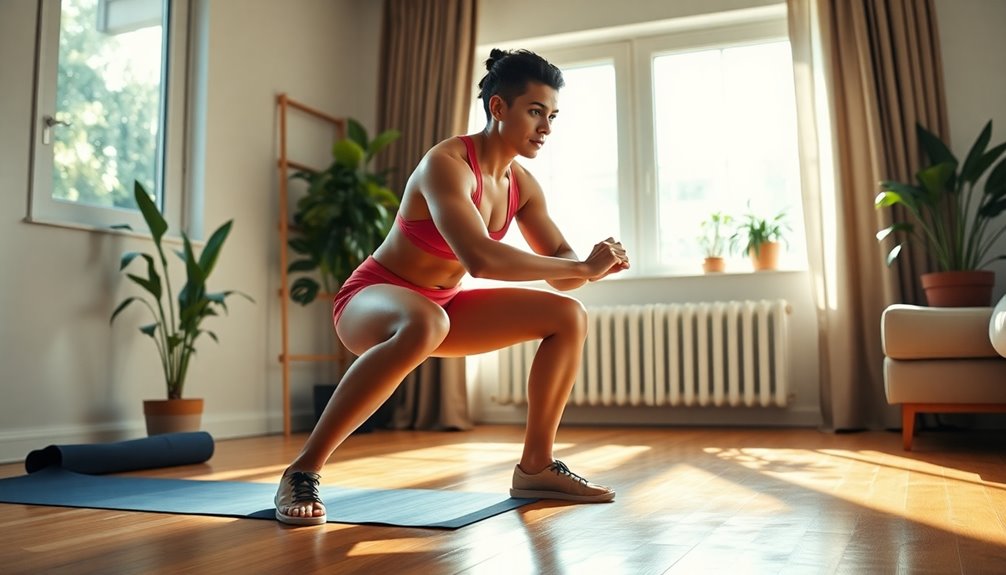
After mastering push-ups, it's time to add squats to your home workout routine. Squats are a fantastic way to strengthen your lower body, particularly your thighs, glutes, and calves. Plus, they engage your core, making them a powerhouse exercise for overall fitness.
To get started, focus on proper form. Stand with your feet shoulder-width apart, and keep your chest up and back straight. As you lower your body, push your hips back as if you're sitting in a chair. Make sure that your knees stay behind your toes and don't cave inward. Aim for thighs parallel to the ground, then push through your heels to return to the starting position.
Once you feel confident with the standard squat, explore variations and modifications to keep your routine fresh and challenging. Try sumo squats for inner thigh engagement or jump squats for a cardio kick. If you're looking for something less intense, wall sits can be a great alternative to build strength without strain. Incorporating mini bands into your routine can enhance muscle tone and provide unique sculpting movements.
Lunges
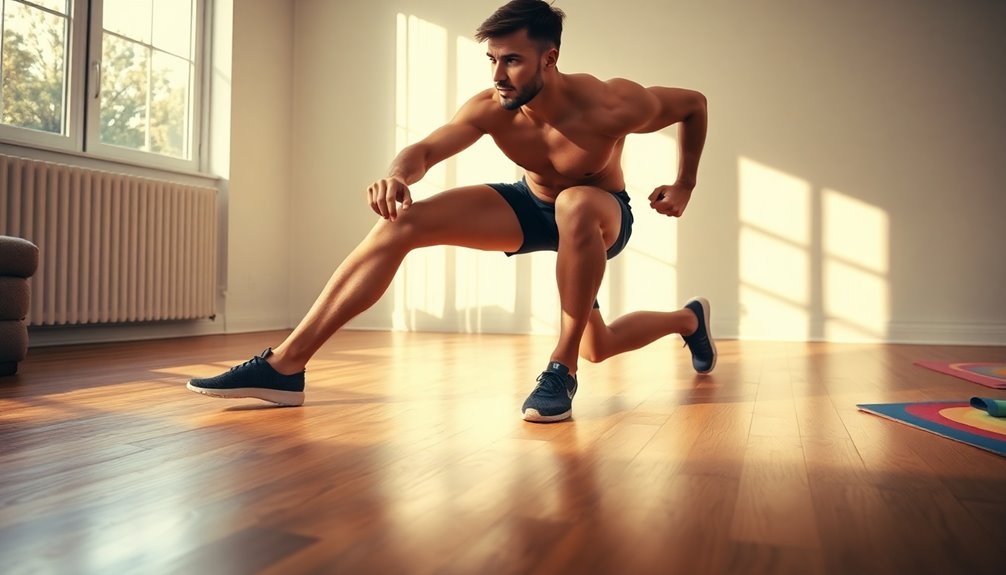
Lunges are a fantastic addition to your home workout routine, targeting your legs and glutes while improving balance and coordination. If you're looking to strengthen your lower body, lunges can be incredibly effective, and with proper form, you'll maximize the benefits while minimizing the risk of injury. Remember, it's all about control and technique.
To perform a lunge correctly, step forward with one leg, lowering your hips until both knees are bent at about a 90-degree angle. Keep your chest up, shoulders back, and make sure your front knee doesn't extend past your toes. Once you feel comfortable, try these variations for beginners:
- Static Lunges: Stay in one position, perfecting form without movement.
- Reverse Lunges: Step back instead of forward, reducing strain on the knees.
- Side Lunges: Step out to the side, targeting different muscle groups.
- Walking Lunges: Add a dynamic element, stepping forward into each lunge.
Incorporating lunges into your routine not only enhances your strength but also fosters a sense of community as you tackle these challenges together with others. A strong core is essential for maintaining balance and stability during lunges, making them even more effective. Whether you're a beginner or looking to spice up your workout, lunges offer a welcoming space for everyone.
Planks
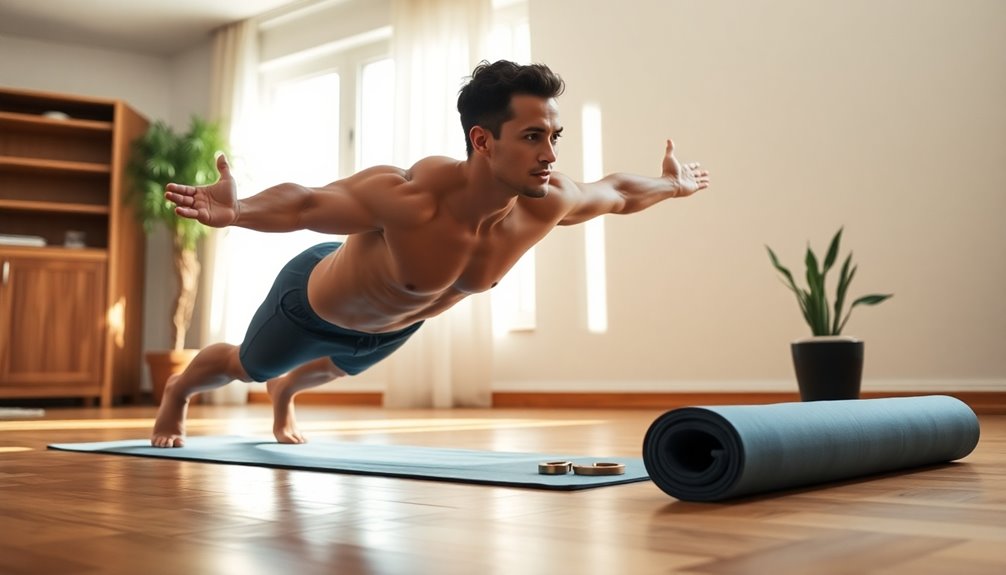
When it comes to building core strength, planks are an essential exercise that you can easily incorporate into your home workout routine. Not only do they target your entire core, but they also engage your shoulders, arms, and even your legs. The benefits of planks are immense—they improve posture, enhance stability, and can even relieve back pain. Additionally, incorporating a healthy diet, such as fat-melting meal-replacement smoothies, can further enhance your fitness results.
To get the most out of your planks, it's pivotal to maintain proper form. Here's a quick guide to help you:
| Proper Form | Common Mistakes |
|---|---|
| Keep your body in a straight line from head to heels. | Letting your hips sag or rise too high. |
| Engage your core and glutes. | Holding your breath. |
| Position your elbows directly under your shoulders. | Looking too far ahead or down. |
Once you've mastered the basic plank, you can explore various variations and advanced modifications to keep things interesting. Side planks, plank jacks, and plank shoulder taps are just a few options to challenge yourself further. Each variation can help you build strength and endurance in different muscle groups.
Burpees
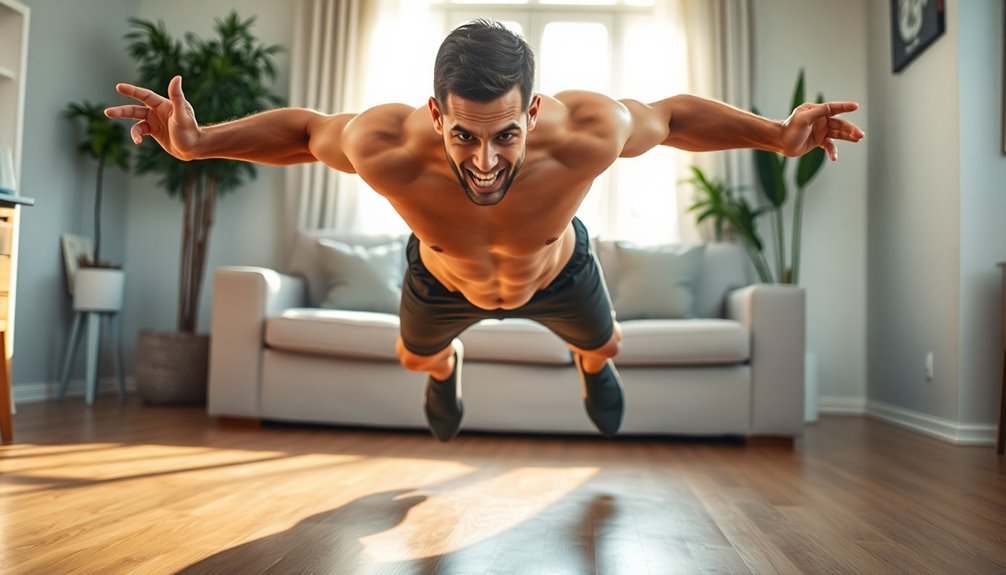
Burpees are a powerhouse exercise that combines strength training and cardio, making them a fantastic addition to your home workout routine. They work multiple muscle groups, including your chest, arms, legs, and core, while also boosting your heart rate. Whether you're a beginner or a seasoned athlete, incorporating burpees into your regimen can elevate your fitness game.
Here are some key benefits of doing burpees:
- Full-body workout: Engage all major muscle groups, enhancing overall strength.
- Cardio boost: Elevate your heart rate, improving cardiovascular health.
- Time-efficient: Get an effective workout in a short amount of time.
- Versatile: Easily adapt burpee variations to match your fitness level.
If you're new to burpees, don't worry! There are plenty of burpee modifications that can help you ease into this dynamic exercise. Start with a step-back burpee instead of jumping back to reduce impact. Focus on your form; keep your back straight and engage your core throughout the movement. Additionally, incorporating burpees into your routine can also help with reversing fatty liver due to their effectiveness in promoting weight loss and improving overall health.
As you build strength and confidence, try different burpee variations like the push-up burpee or the tuck jump burpee to keep things exciting. Remember, it's all about progress, not perfection. You're part of a community striving for better health, and every burpee counts toward your goals. So, get ready to sweat and embrace the challenge!
Mountain Climbers
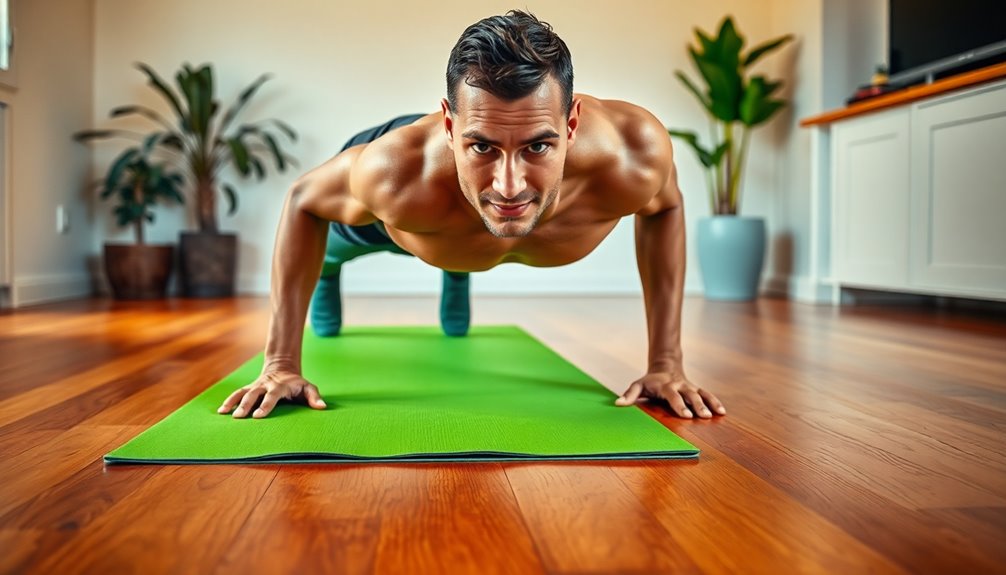
Mountain climbers are an effective way to get your heart pumping while building strength and endurance. This dynamic exercise engages multiple muscle groups, from your core to your legs, making it a fantastic addition to your home workout routine. Not only do you boost your cardiovascular fitness, but you also improve your agility and coordination. Plus, they're perfect for burning calories, helping you reach your fitness goals faster.
One of the great benefits of mountain climbers is their versatility. You can easily modify the intensity to suit your fitness level. If you're just starting out, try doing them at a slower pace or with your hands elevated on a sturdy surface. As you grow stronger, amp up the challenge by increasing your speed or adding a twist to engage your obliques.
There are several variations for mountain climbers that keep your workouts fresh and exciting. For instance, you can try cross-body mountain climbers, where you bring your knees towards the opposite elbows, or even incorporate a push-up between each set of climbers for an added strength boost. Incorporating these exercises into your routine can also support lean muscle building and enhance your overall fitness journey.
Tricep Dips

Tricep dips are a fantastic way to sculpt and strengthen your upper arms without any fancy equipment. You can perform them almost anywhere—whether it's on a sturdy chair, a bench, or even the edge of your coffee table. Not only will they help tone your triceps, but they also engage your shoulders and chest, making them a powerhouse exercise.
Here are some benefits that come with incorporating tricep dips into your routine:
- Builds Upper Body Strength: Strengthen your triceps, shoulders, and chest effectively.
- Versatile Variations: Try bench dips, single-leg dips, or even weighted dips to keep your workouts fresh.
- Improves Functional Fitness: Tricep dips enhance your ability to perform daily tasks that require upper body strength.
- Quick and Efficient: You can do them in under 10 minutes, making them perfect for busy schedules.
- Supports Mental Relaxation: Engaging in physical activity like tricep dips can help promote deep relaxation similar to techniques used in brainwave guidance programs.
However, it's crucial to avoid common mistakes to maximize your results. Many people let their elbows flare out too wide, which can strain your shoulders. Instead, keep your elbows close to your body as you lower yourself.
Also, make sure you're not sinking too deeply, as this can place unnecessary pressure on your joints.
Glute Bridges
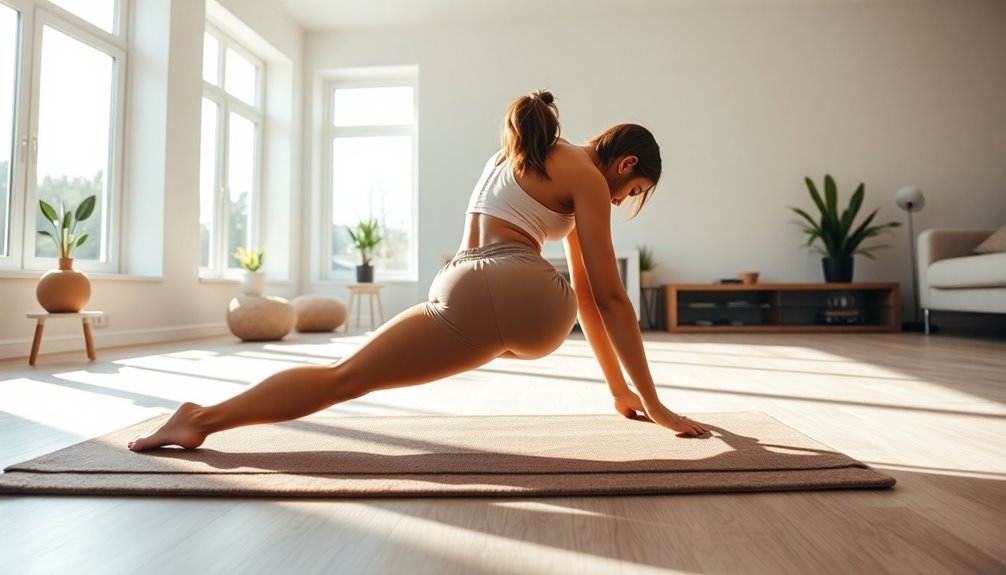
Harness the power of your glutes with glute bridges, an effective bodyweight exercise that targets your posterior chain. This exercise not only strengthens your glutes but also benefits your lower back and hamstrings. By incorporating glute bridge variations, you can add excitement to your routine and keep those muscles challenged.
To perform a glute bridge with proper form, lie on your back with your knees bent and feet flat on the floor, hip-width apart. Press your heels into the ground, engage your core, and lift your hips towards the ceiling. Hold at the top for a moment before lowering back down. Remember, maintaining a neutral spine is essential to avoid common mistakes in glute bridges.
Here's a quick overview of some glute bridge variations and their benefits:
| Variation | Benefits |
|---|---|
| Single-leg Glute Bridge | Builds unilateral strength |
| Elevated Glute Bridge | Increases range of motion |
| Weighted Glute Bridge | Adds resistance for muscle growth |
Incorporating glute bridges into your routine can lead to improved posture, enhanced athletic performance, and increased confidence. Additionally, engaging in exercises like glute bridges can contribute to lowering blood pressure by promoting overall fitness and well-being. So gather your friends or family, and encourage them to join you on this journey to stronger glutes! Remember, you belong to a community that values fitness and health, and every rep counts towards your collective goals. Keep pushing forward; you've got this!
High Knees

High knees are a dynamic exercise that gets your heart pumping and engages your entire lower body. This powerful move not only boosts your cardiovascular health but also strengthens your legs and core. When you perform high knees, you're not just working out; you're also setting the stage for a fun, energetic routine that can be done anytime, anywhere.
To get the most out of high knees, it's important to maintain proper form. Stand tall, engage your core, and drive your knees upward toward your chest. Keep your arms bent at 90 degrees, pumping them in sync with your legs.
Here are some fantastic benefits of adding high knees to your workout routine:
- Improves cardiovascular endurance: Elevate your heart rate for better stamina.
- Increases lower body strength: Target your quads, hamstrings, and calves effectively.
- Enhances agility and coordination: Master your movement patterns for sports and daily activities.
- Burns calories efficiently: High-intensity bursts lead to quicker fat loss.
Additionally, drinking water from SlimCrystal bottles can help improve overall health and complement your fitness routine.
You can also explore variations of high knees, like lateral high knees or high knee sprints, to keep things exciting. Plus, incorporating high knees into HIIT workouts can maximize your training efficiency. So, whether you're a beginner or a seasoned athlete, high knees can fit right into your routine. Get moving, enjoy the energy, and feel the benefits!
Bicycle Crunches
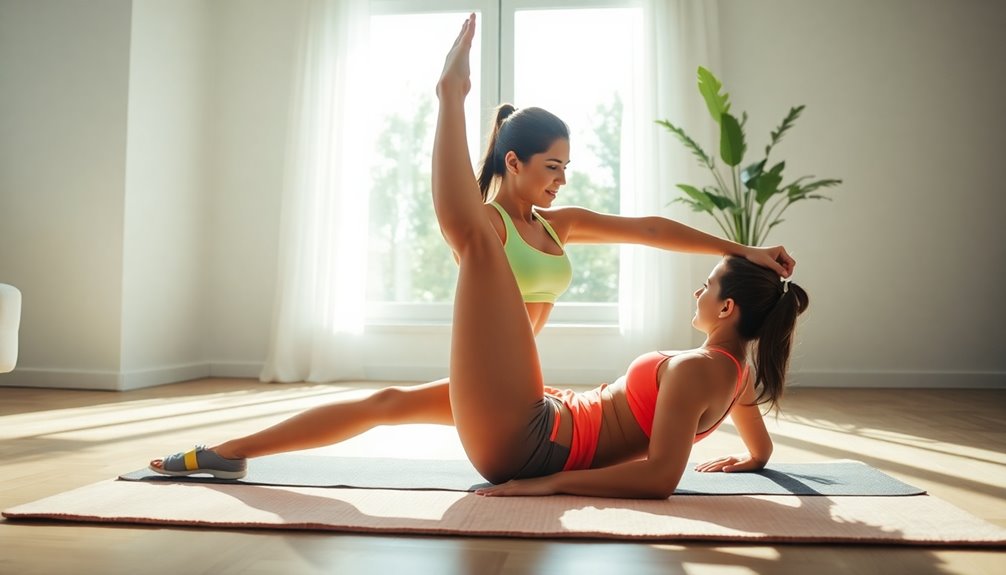
Engage your core with bicycle crunches, a powerful exercise that targets your abdominal muscles while also improving your overall stability. This exercise not only sculpts your abs but also enhances coordination and balance. To perform bicycle crunches effectively, focus on maintaining proper form and rhythm throughout. Additionally, incorporating research-based approaches to your workout routine can further enhance your results, especially for those managing health conditions.
Here's a quick reference table to help you master bicycle crunches:
| Step | Proper Form | Common Mistakes |
|---|---|---|
| Start Position | Lie on your back, knees bent, feet flat. | Pulling on your neck. |
| Crunch Movement | Lift shoulders and twist, bringing elbow to opposite knee. | Not rotating enough. |
| Leg Extension | Extend the opposite leg straight out. | Letting your lower back arch. |
| Repeat | Alternate sides in a smooth motion. | Hurrying the movement. |
To execute bicycle crunches correctly, keep your elbows wide and avoid pulling on your head. Engage your core, and make sure your lower back stays pressed into the floor. Remember, it's about the quality of each repetition, not just the quantity.
Watch out for common mistakes like hurrying through the exercise or failing to rotate fully. By maintaining proper form, you'll not only maximize the effectiveness of the workout but also prevent injury.
Frequently Asked Questions
How Often Should I Do Bodyweight Exercises for Best Results?
To get the best results, aim for bodyweight exercises three to four times a week. This frequency allows your muscles to recover while maximizing benefits like strength and endurance.
Start with fundamental movements, then progressively challenge yourself by increasing reps or adding variations.
Can Bodyweight Exercises Help With Weight Loss?
Can bodyweight exercises really help you shed those extra pounds? Absolutely! When combined with smart nutrition tips, they can boost your metabolism and promote muscle building, leading to effective weight loss.
Plus, you'll discover a sense of belonging in the fitness community as you share your progress. Commit to consistency, and you'll not only transform your body but also build confidence.
Embrace the journey; your goals are within reach!
Do I Need Equipment for Bodyweight Exercises?
You don't need any equipment for bodyweight exercises, which makes them super accessible! You can use your own body as resistance, so it's all about your motivation.
If you're tight on space, you can still find room for effective moves like push-ups or squats. Consider alternatives like chairs or walls if you want to mix it up.
Embrace the freedom of working out anywhere—your journey toward fitness starts right where you are!
How Can I Modify Exercises for Beginners?
To modify exercises for beginners, focus on technique modifications that guarantee safety and proper form. Start with smaller ranges of motion or reduce the intensity. Incorporate progression options, like adding repetitions or increasing duration as you gain strength.
Remember, everyone's journey is unique, so don't rush; celebrate each improvement. You're building a solid foundation, and with patience, you'll feel more confident and capable in your fitness journey.
You've got this!
What's the Best Way to Warm up Before Workouts?
Warming up before workouts is like tuning an orchestra before a concert; it sets the stage for a great performance. Start with some dynamic stretching to loosen your muscles, then incorporate foam rolling to release tension.
A quick cardio workout, like jumping rope, gets your heart rate up and prepares you mentally and physically. You'll feel energized and ready to tackle your session, ensuring you belong to a community that prioritizes health and fitness.
Conclusion
You've got the tools to sculpt your body right at home! With these 10 bodyweight exercises, you can turn your living room into a personal gym. Each move is like a brushstroke on the canvas of your fitness journey, painting strength and resilience. So, lace up your shoes, embrace the challenge, and remember: every rep is a step closer to your goals. You're not just working out; you're building a stronger, healthier you. Now go release your inner warrior!

